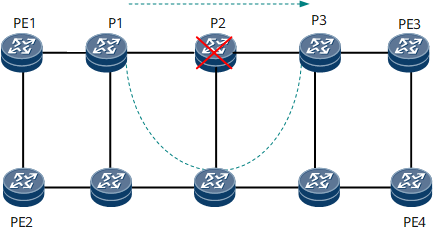Faults on an Intermediate Node or on the Link Connected to It - LDP FRR/TE FRR
In Label Distribution Protocol (LDP)/traffic engineering (TE) scenarios, if there are intermediate devices between PEs, use BFD to monitor the link between the PEs.
As shown in Figure 1, an LDP LSP serves as a public network tunnel and TE is enabled between Ps to ensure quality of service (QoS). This deployment enhances the QoS across the entire network and simplifies TE deployment during PE replacements. If no intermediate devices exist and a fault occurs on the link between P1 and P2, or P2 fails on a non-broadcast network, an LDP FRR switchover is performed on PE1 to ensure that the switchover takes less than 50 ms.
TE FRR/LDP FRR switchovers depend on the detection of electrical or optical signals on an interface. If intermediate devices exist and a link fails, a router cannot detect the interruption of optical signals and therefore a switchover cannot be performed. BFD resolves this issue.

If both LDP FRR and IP FRR are available, IP FRR is preferred.
